SUBARU WRX 2018 Manual Online
Manufacturer: SUBARU, Model Year: 2018, Model line: WRX, Model: SUBARU WRX 2018Pages: 578, PDF Size: 33.21 MB
Page 81 of 578
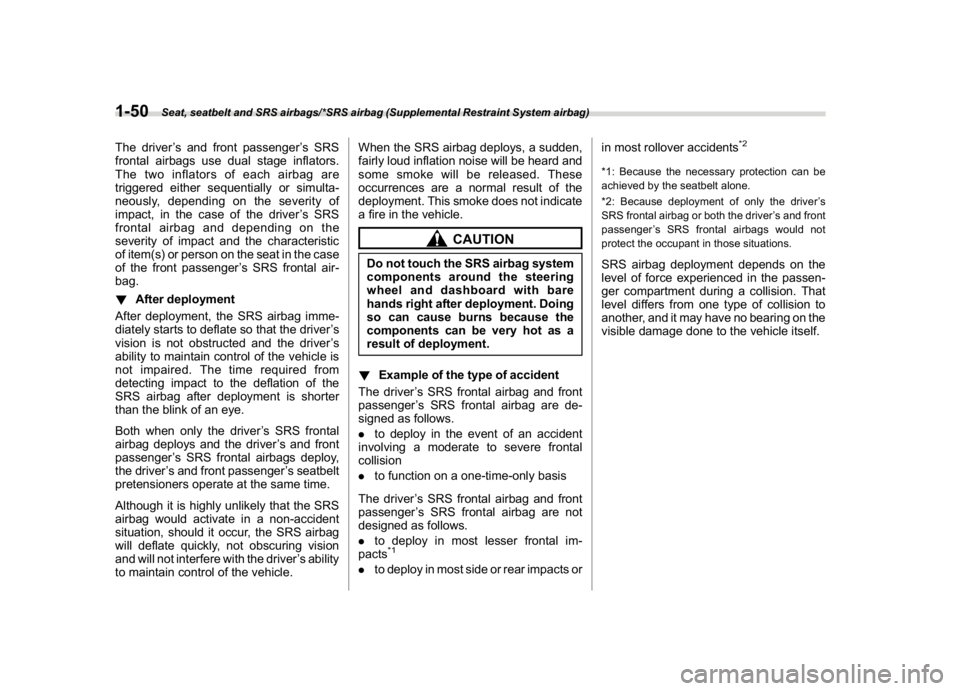
(82,1)
北米Model "A1700BE-B" EDITED: 2017/ 10/ 11
The driver’s and front passenger’s SRS
frontal airbags use dual stage inflators.
The two inflators of each airbag are
triggered either sequentially or simulta-
neously, depending on the severity of
impact, in the case of the driver’s SRS
frontal airbag and depending on the
severity of impact and the characteristic
of item(s) or person on the seat in the case
of the front passenger’s SRS frontal air-
bag.
!After deployment
After deployment, the SRS airbag imme-
diately starts to deflate so that the driver’s
vision is not obstructed and the driver’s
ability to maintain control of the vehicle is
not impaired. The time required from
detecting impact to the deflation of the
SRS airbag after deployment is shorter
than the blink of an eye.
Both when only the driver’s SRS frontal
airbag deploys and the driver’s and front
passenger’s SRS frontal airbags deploy,
the driver’s and front passenger’s seatbelt
pretensioners operate at the same time.
Although it is highly unlikely that the SRS
airbag would activate in a non-accident
situation, should it occur, the SRS airbag
will deflate quickly, not obscuring vision
and will not interfere with the driver’s ability
to maintain control of the vehicle.When the SRS airbag deploys, a sudden,
fairly loud inflation noise will be heard and
some smoke will be released. These
occurrences are a normal result of the
deployment. This smoke does not indicate
a fire in the vehicle.
CAUTION
Do not touch the SRS airbag system
components around the steering
wheel and dashboard with bare
hands right after deployment. Doing
so can cause burns because the
components can be very hot as a
result of deployment.
!Example of the type of accident
The driver’s SRS frontal airbag and front
passenger’s SRS frontal airbag are de-
signed as follows.
.to deploy in the event of an accident
involving a moderate to severe frontal
collision
.to function on a one-time-only basis
The driver’s SRS frontal airbag and front
passenger’s SRS frontal airbag are not
designed as follows.
.to deploy in most lesser frontal im-
pacts
*1
.to deploy in most side or rear impacts orin most rollover accidents
*2
*1: Because the necessary protection can be
achieved by the seatbelt alone.
*2: Because deployment of only the driver’s
SRS frontal airbag or both the driver’s and front
passenger’s SRS frontal airbags would not
protect the occupant in those situations.SRS airbag deployment depends on the
level of force experienced in the passen-
ger compartment during a collision. That
level differs from one type of collision to
another, and it may have no bearing on the
visible damage done to the vehicle itself.
Seat, seatbelt and SRS airbags/*SRS airbag (Supplemental Restraint System airbag)
1-50
Page 82 of 578
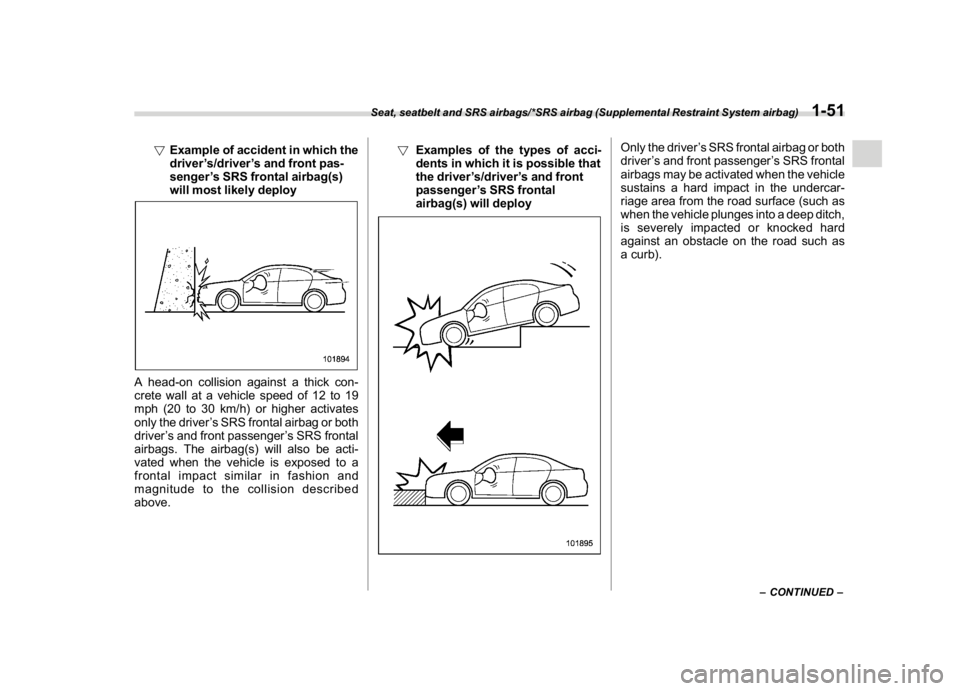
(83,1)
北米Model "A1700BE-B" EDITED: 2017/ 10/ 11
!Example of accident in which the
driver’s/driver’s and front pas-
senger’s SRS frontal airbag(s)
will most likely deploy
A head-on collision against a thick con-
crete wall at a vehicle speed of 12 to 19
mph (20 to 30 km/h) or higher activates
only the driver’s SRS frontal airbag or both
driver’s and front passenger’s SRS frontal
airbags. The airbag(s) will also be acti-
vated when the vehicle is exposed to a
frontal impact similar in fashion and
magnitude to the collision described
above.!Examples of the types of acci-
dents in which it is possible that
the driver’s/driver’s and front
passenger’s SRS frontal
airbag(s) will deploy
Only the driver’s SRS frontal airbag or both
driver’s and front passenger’s SRS frontal
airbags may be activated when the vehicle
sustains a hard impact in the undercar-
riage area from the road surface (such as
when the vehicle plunges into a deep ditch,
is severely impacted or knocked hard
against an obstacle on the road such as
a curb).
–CONTINUED–
Seat, seatbelt and SRS airbags/*SRS airbag (Supplemental Restraint System airbag)
1-51
1
Page 83 of 578
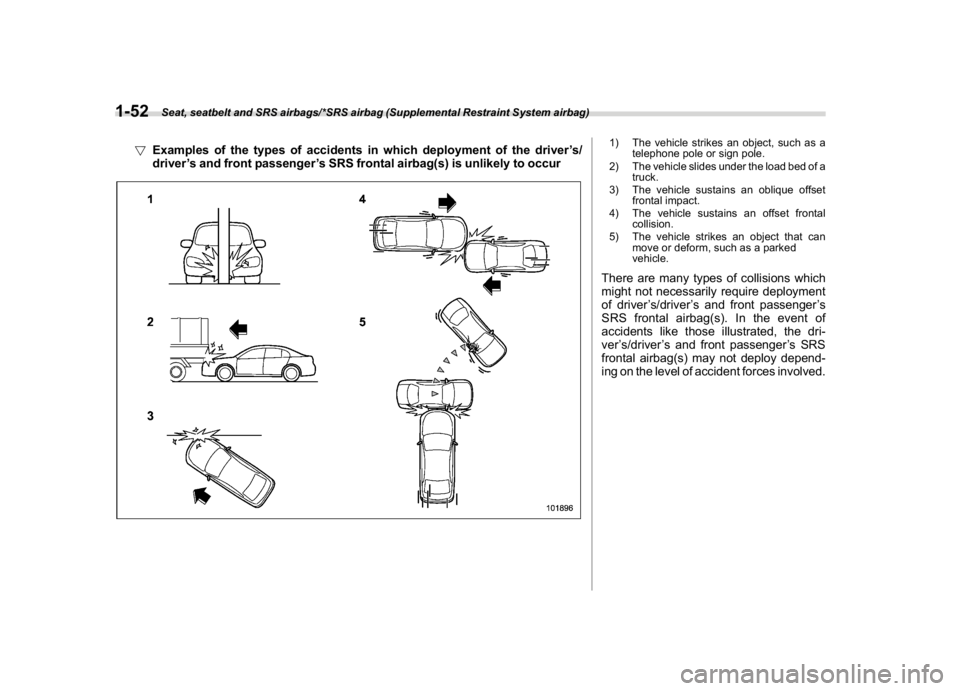
(84,1)
北米Model "A1700BE-B" EDITED: 2017/ 10/ 11
!Examples of the types of accidents in which deployment of the driver’s/
driver’s and front passenger’s SRS frontal airbag(s) is unlikely to occur
1) The vehicle strikes an object, such as a
telephone pole or sign pole.
2) The vehicle slides under the load bed of a
truck.
3) The vehicle sustains an oblique offset
frontal impact.
4) The vehicle sustains an offset frontal
collision.
5) The vehicle strikes an object that can
move or deform, such as a parked
vehicle.There are many types of collisions which
might not necessarily require deployment
of driver’s/driver’s and front passenger’s
SRS frontal airbag(s). In the event of
accidents like those illustrated, the dri-
ver’s/driver’s and front passenger’s SRS
frontal airbag(s) may not deploy depend-
ing on the level of accident forces involved.
Seat, seatbelt and SRS airbags/*SRS airbag (Supplemental Restraint System airbag)
1-52
Page 84 of 578
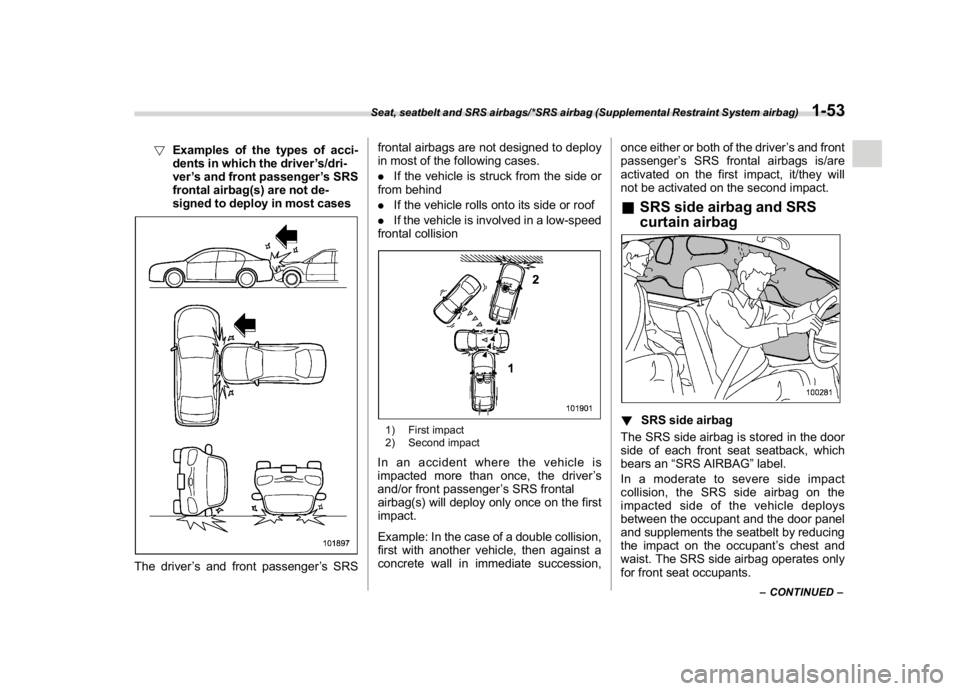
(85,1)
北米Model "A1700BE-B" EDITED: 2017/ 10/ 11
!Examples of the types of acci-
dents in which the driver’s/dri-
ver’s and front passenger’s SRS
frontal airbag(s) are not de-
signed to deploy in most cases
The driver’s and front passenger’s SRSfrontal airbags are not designed to deploy
in most of the following cases.
.If the vehicle is struck from the side or
from behind
.If the vehicle rolls onto its side or roof
.If the vehicle is involved in a low-speed
frontal collision
1) First impact
2) Second impactIn an accident where the vehicle is
impacted more than once, the driver’s
and/or front passenger’s SRS frontal
airbag(s) will deploy only once on the first
impact.
Example: In the case of a double collision,
first with another vehicle, then against a
concrete wall in immediate succession,once either or both of the driver’s and front
passenger’s SRS frontal airbags is/are
activated on the first impact, it/they will
not be activated on the second impact.
&SRS side airbag and SRS
curtain airbag!SRS side airbag
The SRS side airbag is stored in the door
side of each front seat seatback, which
bears an“SRS AIRBAG”label.
Inamoderatetoseveresideimpact
collision, the SRS side airbag on the
impacted side of the vehicle deploys
between the occupant and the door panel
and supplements the seatbelt by reducing
the impact on the occupant’s chest and
waist. The SRS side airbag operates only
for front seat occupants.
–CONTINUED–
Seat, seatbelt and SRS airbags/*SRS airbag (Supplemental Restraint System airbag)
1-53
1
Page 85 of 578
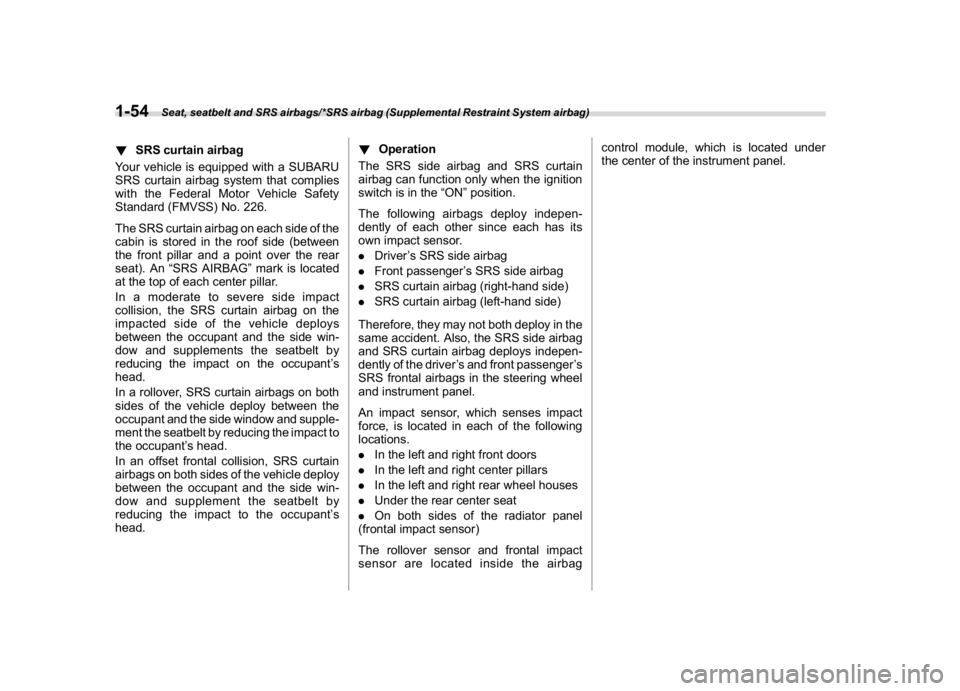
(86,1)
北米Model "A1700BE-B" EDITED: 2017/ 10/ 11
!SRS curtain airbag
Your vehicle is equipped with a SUBARU
SRS curtain airbag system that complies
with the Federal Motor Vehicle Safety
Standard (FMVSS) No. 226.
The SRS curtain airbag on each side of the
cabin is stored in the roof side (between
the front pillar and a point over the rear
seat). An“SRS AIRBAG”mark is located
at the top of each center pillar.
Inamoderatetoseveresideimpact
collision, the SRS curtain airbag on the
impacted side of the vehicle deploys
between the occupant and the side win-
dow and supplements the seatbelt by
reducing the impact on the occupant’s
head.
In a rollover, SRS curtain airbags on both
sides of the vehicle deploy between the
occupant and the side window and supple-
ment the seatbelt by reducing the impact to
the occupant’s head.
In an offset frontal collision, SRS curtain
airbags on both sides of the vehicle deploy
between the occupant and the side win-
dow and supplement the seatbelt by
reducing the impact to the occupant’s
head.!Operation
The SRS side airbag and SRS curtain
airbag can function only when the ignition
switch is in the“ON”position.
The following airbags deploy indepen-
dently of each other since each has its
own impact sensor.
.Driver’s SRS side airbag
.Front passenger’s SRS side airbag
.SRS curtain airbag (right-hand side)
.SRS curtain airbag (left-hand side)
Therefore, they may not both deploy in the
same accident. Also, the SRS side airbag
and SRS curtain airbag deploys indepen-
dently of the driver’s and front passenger’s
SRS frontal airbags in the steering wheel
and instrument panel.
An impact sensor, which senses impact
force, is located in each of the following
locations.
.In the left and right front doors
.In the left and right center pillars
.In the left and right rear wheel houses
.Under the rear center seat
.On both sides of the radiator panel
(frontal impact sensor)
The rollover sensor and frontal impact
sensor are located inside the airbagcontrol module, which is located under
the center of the instrument panel.
Seat, seatbelt and SRS airbags/*SRS airbag (Supplemental Restraint System airbag)
1-54
Page 86 of 578
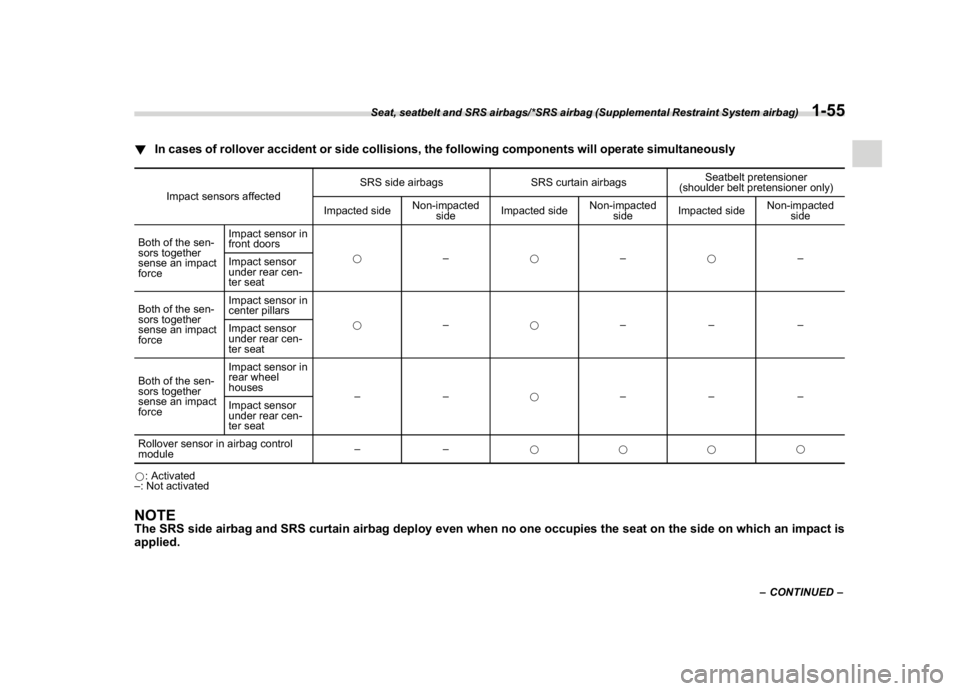
(87,1)
北米Model "A1700BE-B" EDITED: 2017/ 10/ 11
!In cases of rollover accident or side collisions, the following components will operate simultaneously
Impact sensors affectedSRS side airbags SRS curtain airbagsSeatbelt pretensioner
(shoulder belt pretensioner only)
Impacted sideNon-impacted
sideImpacted sideNon-impacted
sideImpacted sideNon-impacted
side
Both of the sen-
sors together
sense an impact
forceImpact sensor in
front doors
*–*–*–
Impact sensor
under rear cen-
ter seat
Both of the sen-
sors together
sense an impact
forceImpact sensor in
center pillars
*–*–––
Impact sensor
under rear cen-
ter seat
Both of the sen-
sors together
sense an impact
forceImpact sensor in
rear wheel
houses
––*–––
Impact sensor
under rear cen-
ter seat
Rollover sensor in airbag control
module––****
*: Activated
–: Not activated
NOTEThe SRS side airbag and SRS curtain airbag deploy even when no one occupies the seat on the side on which an impact is
applied.
–CONTINUED–
Seat, seatbelt and SRS airbags/*SRS airbag (Supplemental Restraint System airbag)
1-55
1
Page 87 of 578
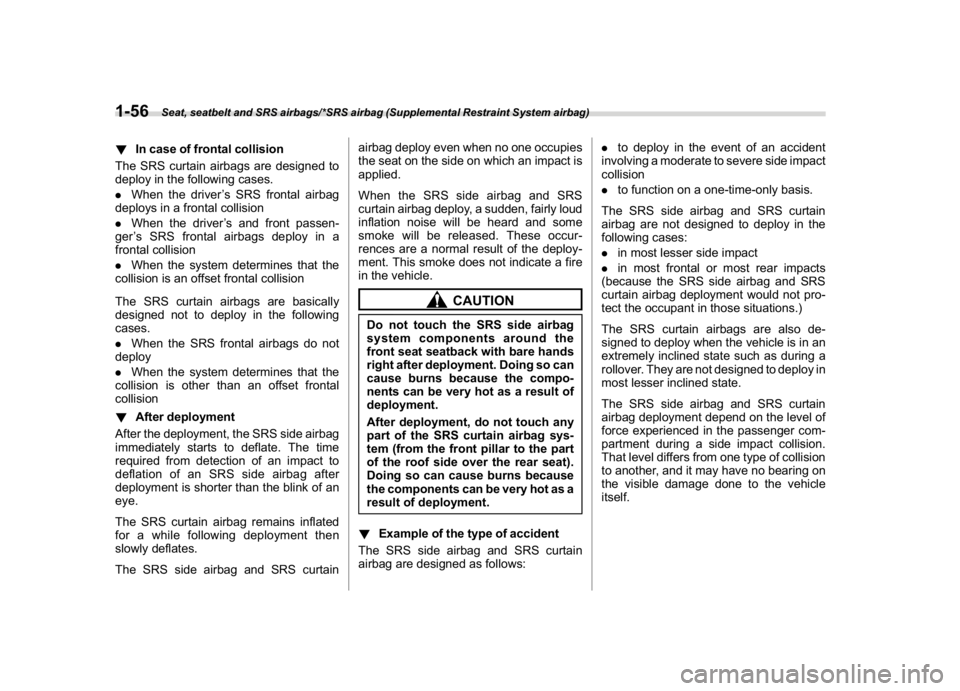
(88,1)
北米Model "A1700BE-B" EDITED: 2017/ 10/ 11
!In case of frontal collision
The SRS curtain airbags are designed to
deploy in the following cases.
.When the driver’s SRS frontal airbag
deploys in a frontal collision
.When the driver’s and front passen-
ger’s SRS frontal airbags deploy in a
frontal collision
.When the system determines that the
collision is an offset frontal collision
The SRS curtain airbags are basically
designed not to deploy in the following
cases.
.When the SRS frontal airbags do not
deploy
.When the system determines that the
collision is other than an offset frontal
collision
!After deployment
After the deployment, the SRS side airbag
immediately starts to deflate. The time
required from detection of an impact to
deflation of an SRS side airbag after
deployment is shorter than the blink of an
eye.
The SRS curtain airbag remains inflated
for a while following deployment then
slowly deflates.
The SRS side airbag and SRS curtainairbag deploy even when no one occupies
the seat on the side on which an impact is
applied.
When the SRS side airbag and SRS
curtain airbag deploy, a sudden, fairly loud
inflation noise will be heard and some
smoke will be released. These occur-
rences are a normal result of the deploy-
ment. This smoke does not indicate a fire
in the vehicle.
CAUTION
Do not touch the SRS side airbag
system components around the
front seat seatback with bare hands
right after deployment. Doing so can
cause burns because the compo-
nents can be very hot as a result of
deployment.
After deployment, do not touch any
part of the SRS curtain airbag sys-
tem (from the front pillar to the part
of the roof side over the rear seat).
Doing so can cause burns because
the components can be very hot as a
result of deployment.
!Example of the type of accident
The SRS side airbag and SRS curtain
airbag are designed as follows:.to deploy in the event of an accident
involving a moderate to severe side impact
collision
.to function on a one-time-only basis.
The SRS side airbag and SRS curtain
airbag are not designed to deploy in the
following cases:
.in most lesser side impact
.in most frontal or most rear impacts
(because the SRS side airbag and SRS
curtain airbag deployment would not pro-
tect the occupant in those situations.)
The SRS curtain airbags are also de-
signed to deploy when the vehicle is in an
extremely inclined state such as during a
rollover. They are not designed to deploy in
most lesser inclined state.
The SRS side airbag and SRS curtain
airbag deployment depend on the level of
force experienced in the passenger com-
partment during a side impact collision.
That level differs from one type of collision
to another, and it may have no bearing on
the visible damage done to the vehicle
itself.
Seat, seatbelt and SRS airbags/*SRS airbag (Supplemental Restraint System airbag)
1-56
Page 88 of 578
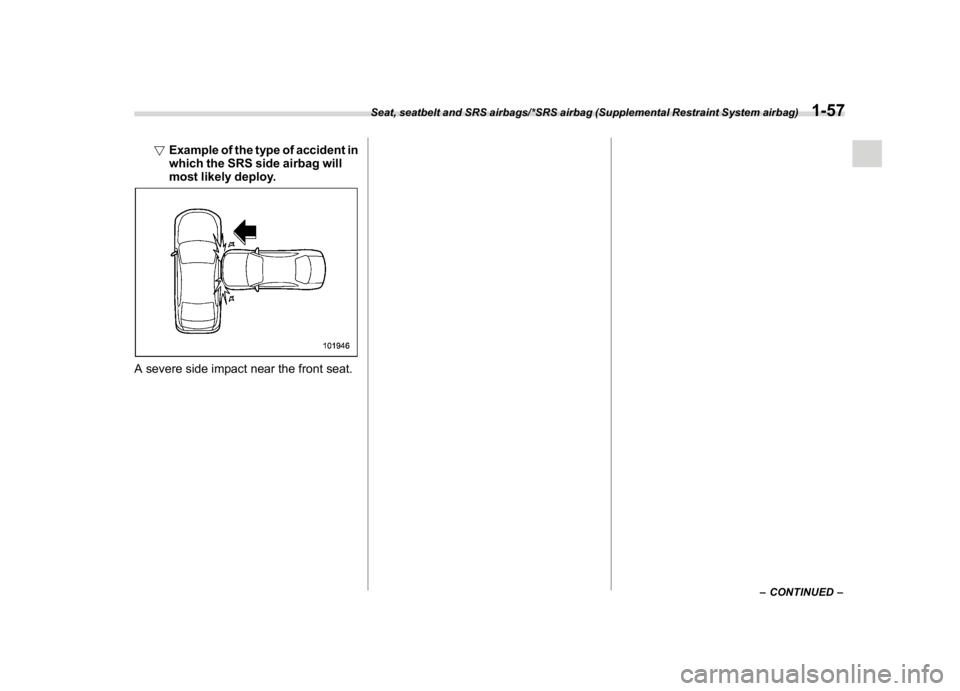
(89,1)
北米Model "A1700BE-B" EDITED: 2017/ 10/ 11
!Example of the type of accident in
which the SRS side airbag will
most likely deploy.
A severe side impact near the front seat.
–CONTINUED–
Seat, seatbelt and SRS airbags/*SRS airbag (Supplemental Restraint System airbag)
1-57
1
Page 89 of 578
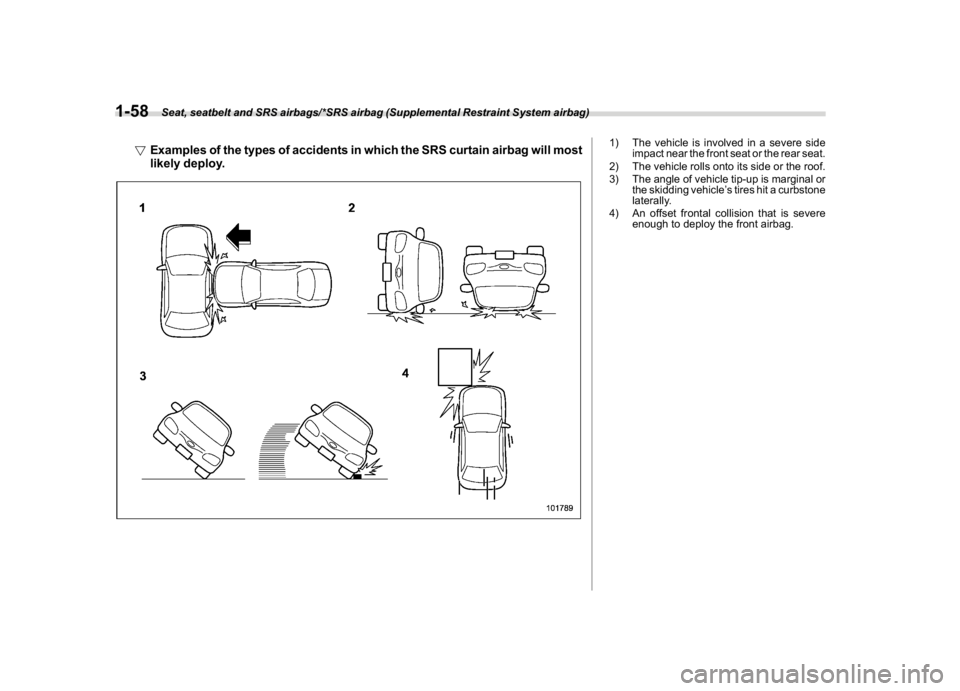
(90,1)
北米Model "A1700BE-B" EDITED: 2017/ 10/ 11
!Examples of the types of accidents in which the SRS curtain airbag will most
likely deploy.
1) The vehicle is involved in a severe side
impact near the front seat or the rear seat.
2) The vehicle rolls onto its side or the roof.
3) The angle of vehicle tip-up is marginal or
the skidding vehicle’s tires hit a curbstone
laterally.
4) An offset frontal collision that is severe
enough to deploy the front airbag.
Seat, seatbelt and SRS airbags/*SRS airbag (Supplemental Restraint System airbag)
1-58
Page 90 of 578
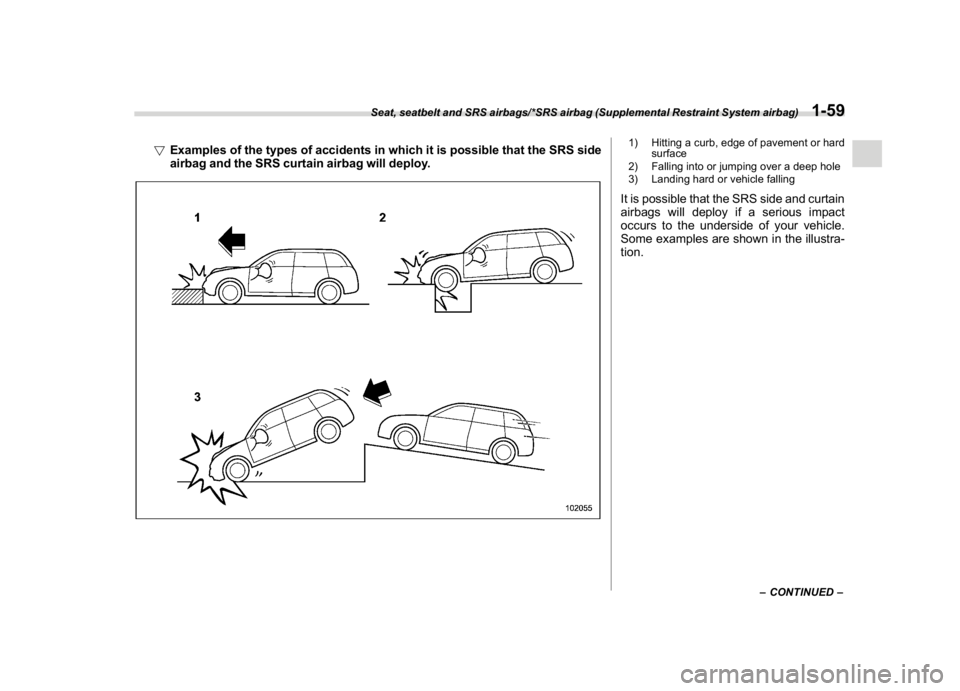
(91,1)
北米Model "A1700BE-B" EDITED: 2017/ 10/ 11
!Examples of the types of accidents in which it is possible that the SRS side
airbag and the SRS curtain airbag will deploy.
1) Hitting a curb, edge of pavement or hard
surface
2) Falling into or jumping over a deep hole
3) Landing hard or vehicle fallingIt is possible that the SRS side and curtain
airbags will deploy if a serious impact
occurs to the underside of your vehicle.
Some examples are shown in the illustra-
tion.
–CONTINUED–
Seat, seatbelt and SRS airbags/*SRS airbag (Supplemental Restraint System airbag)
1-59
1